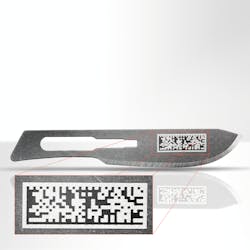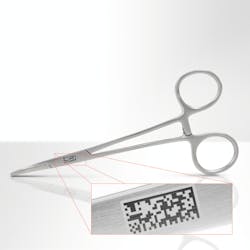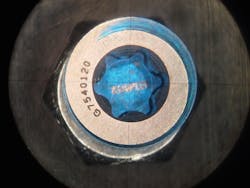Lasers for medical device marking
Tom Goodnow and Faycal Benayad-Cherif
Since the Food and Drug Association (FDA) adopted a new rule for the identification of medical products and made the marking of all devices with a unique device identifier (UDI) mandatory, the majority of medical device products and parts require marking. When it comes to implants such as bone plates or hip stems, or invasive surgical tools and devices such as catheters or minimally invasive instruments, medical device manufacturers have to mark 100 percent of their products. The reasons for manufacturers to mark their medical products are varied, whereas the range of tools and technologies that can be utilized to apply these valuable marks is limited. Laser marking is one of the preferred marking technologies that comes with many benefits for manufacturers worldwide.
Manufacturers' needs
Zero defect marking, traceability, and UDI marking are key product requirements for medical device producers. Their products have to be marked with permanent and absolutely traceable marks for a variety of reasons:
- Traceability: Medical devices have to be marked to properly identify and trace throughout their life cycle to improve patient safety, simplify product recalls, and optimize market surveillance
- Product liability
- Product safety (trademark protection and protection from product piracy)
- Product identification: This includes the identification of the manufacturer, the production, and the device itself
- Regulatory compliance, such as with the UDI directive
- Quality assurance and process reliability
Producers have strict standards regarding marking contents and they need to ensure that only the correct mark is applied on the correct position of the correct part. Their standards apply for what has to be marked (2D codes, logo types, or alphanumeric contents) and where the mark has to be applied. That includes the certainty that the correct part is used for marking and that this part is being marked at the very position it should be marked (mark placement).
The marking contents requested by the industry range from simple serial numbers or date and lot codes through images, graphics, and company or trademark logos to complex codes such as 2D and barcodes, and multilanguage fonts.
When it comes to the materials, a large variety of materials is being processed and thus has to be marked. Most common materials include:
- Metals (stainless steel, platinum, titanium, anodized titanium, chrome-plated steel, and others)
- Plastics (many types, including polycarbonate, ABS, Delran, PEEK, HDPE, silicone, and others in many different colors)
The requirements for marking on metal devices are diverse and depend on the respective application. However, most of them include the need for resistance to acids and high-alkaline cleaning methods, as well as resistance to corrosion, water, steam, humidity, and high temperature sterilization. The requirements regarding the material behavior of marked plastics are just as diverse—sometimes, a high-contrast mark has to be applied, and often, manufacturers have to ensure that the marking itself does not harm the invasive products. Product surfaces have to stay smooth to hinder germs and bacteria growth.
General requirements for medical device marking include clear legibility and readability (machine- and human-readable), uncompromising durability of the mark, reliable traceability, and counterfeit-proof markings.
Marking: Critical in the production process
Usually, medical devices are marked at the end of the production process; sometimes, marking is the final step in the process chain. At this late stage of manufacture, product scrap caused by mismarkings, incomplete markings, or incorrect markings is extremely costly. If mark errors can be corrected, they are very costly to correct. If they can't be corrected, the device itself is scrap.
Most often, medical devices come in many shapes and sizes. Some parts require very small marking contents, while others require very large marks. Also, the information contained can vary from part to part, batch to batch, or lot to lot. Medical device manufacturers are trying to achieve zero-defect marking to eliminate errors due to fixture problems, operator errors, or other random defects. That is why they have to control the marking process at the work-cell level and prevent bad marks from being placed on the part, correct marks from being placed on the wrong part, or making marks that do not survive the manufacturing process (for instance, post-mark passivation).
Manufacturers mark for their customers
Manufacturers have to guarantee that the marks on their parts are permanent to be completely readable and traceable all along their life cycle: from the manufacturing site where the device was produced to the operating room where the device is used or implanted on a patient. Medical manufacturers have to ensure that the correct information is marked on the correct part in the right location and that this identifying information is legible at any time. All marks have to meet accuracy specifications; badly marked parts must never make their way to the customer.
Marking benefits medical device manufacturers
Currently, there are few technologies for marking medical parts. Laser marking is the preferred method, as ink jet, hot foil, chemical etching, and screen printing methods cannot be tolerated for marking implants or invasive surgical tools due to chemical contaminants and the nonpermanent mark. Dental drills, surgical tools and instruments, bone screws, and other implants are all typically laser marked, as laser marking is a non-contact process that provides high-quality, high-precision marks that are permanent and clearly legible. Also, laser marking doesn't affect the surface properties of the device. As a result, laser marking has become the preferred identification processes.
Manufacturers typically prefer turnkey solutions that include:
- The marking laser with a scanning system
- The marking software
- An interface to their house manufacturing control system for process control
- An integrated vision system that ensures quality assurance and process reliability
- Everything combined in a laser class 1 workstation that can deliver a complete manufacturing process to the producer's factory floor.
Manufacturers require more than just the technical solution—they demand application consulting, installation, and service and support on a global scale. Medical device manufacturers are typically high-mix and low- to medium-volume. They often face the challenge of processing small, single-use devices in high demand with ever-increasing reliability requirements. For these reasons, they value systems that are flexible and make changeover from part to part and batch to batch a convenient, easy process.
A closed-loop marking solution
Laser marking delivers high-quality and high-precision marks on a variety of materials. Many suppliers offer different solutions; however, only a few provide real turnkey and closed-loop solutions that offer additional value. To that end, FOBA's closed-loop medical device marking solution helps manufacturers comply with regulations, and is also used for marking and reading 2D codes with just one laser and its built-in vision system. Parts are validated prior to marking and with the help of a vision system for intelligent mark positioning, only the correct mark is applied at the correct position on the correct part. Marking contents are then verified while the part is still in the machine.
Included in a closed-loop process is pre- and post-mark validation to eliminate potential marking errors by use of FOBA's patented vision system. Since the vision-assisted marking is integrated into the FOBA systems, third-party hardware or a separate inspection process are not necessary to control the marking process and check for errors.
Pre-mark verification with FOBA vision includes:
- Part validation, which prevents users from marking the wrong part
- Pre-mark verification to verify that the part is not already marked
- Mark alignment, which is a tool that aligns the mark to the part
The post-mark verification process, which is unique in the market and currently only offered by FOBA, includes:
- Mark verification (validates that marks are placed where they are expected)
- Optical Character Verification (OCV, which validates that every marked character matches the expected content)
- 2D code validation reads the content of 1D and 2D datamatrix and QR codes, which is particularly important for compliance with UDI
This extensive mark verification approach has the potential to address and prevent most of the five major components of marking errors and defects that cause costly waste. Users benefit from less scrap, a better product and marking quality, a repeatedly accurate marking process, a cost-reducing automated process, and an increase in production efficiency. They benefit with a sophisticated process solution rather than a system solution.
Laser marking solves medical device marking challenges
Vanadate, Nd:YAG, and fiber lasers apply excellent annealing marks, or so-called black marks, on a variety of metal substrates, including steel, stainless steel, titanium, anodized titanium, brass, bronze, chrome, and others. Black markings on stainless steel are permanent and can't be degraded by sterilization and autoclaving. The device's surface is laser-annealed by oxidizing the stainless steel; a black chromium layer is generated on top of the base material and the surface remains smooth. Any indents or changes to the surface properties could result in potential areas for bacteria to grow; therefore, a smooth surface is essential to ensure thorough sterilization of the instrument.Plastic medical devices are used for cannula or catheters, and are often made from sensitive materials. Critical plastics like these are typically marked with UV lasers, as these are capable of applying smooth, high-quality, and high-contrast marks without using solvents or additives. During marking with a UV laser, the product's surface is colored photochemically. The marking process produces low local heating so that delicate and sensitive plastic products remain largely without surface damage. The surface remains smooth, making it impossible for germs to take root.
Medical devices have to carry a clearly machine-readable code (UDI) for distinctive and fast global identification. Laser markers apply these permanent codes that help improve consumer and patient safety, and ensure safe and uncompromising traceability over the complete life cycle of the product. One major requirement for UDI marks is that they are properly marked. This check can be made, for example, with FOBA's OCV right after marking, which validates that every laser-marked character matches the expected content and is clearly readable in just a few milliseconds. In case errors should happen, this helps to detect them as early as possible to reduce costly waste.Marking of bone screws
Laser marking of bone screws presents many challenges, including the positioning of small characters (for example, 0.2mm high) in a very limited area (such as a 3mm-diameter screw head) and the ability to do this repeatedly without operator adjustment of the laser parameters. Bone screws are manufactured in many sizes that, at first glance, can look the same, so it is critical to confirm the bone screw type to ensure that the correct information is marked for that particular part. Failure to do so can result in costly consequences.
The code positioning and quality of mark on screw heads must be reproducible to eliminate any procedural adjustment by the operator. Precise positioning of the mark in the target area without expensive fixtures can also reduce overall production costs. A vision alignment tool, like FOBA's IMP, provides a vision model to locate a screw head location and mark it accurately. This achievement allows operators to significantly reduce the revalidation and marking procedures, which can take up to 80 percent of production time. Marking repeatability on bone screws can be as accurate as 25μm, therefore allowing manufacturers to mark contents into tight spaces.
In summary, there is much more to marking medical devices than just complying with regulations. All medical products have to be marked properly in the first place, whether manufacturers have to comply with global standards and apply all ID marks reliably with repeat accuracy or they have to ensure product quality. Absolutely traceable marks are indispensable to ensure correct part identification. Laser marking is the ideal method to create these marks and at the same time offers an increase in production efficiency and decrease in costly product scrap.
TOM GOODNOW is sales manager and FAYCAL BENAYAD-CHERIF ([email protected]) is product manager for FOBA Laser Marking and Engraving, Boxborough, MA.


